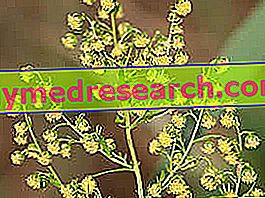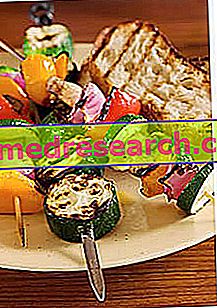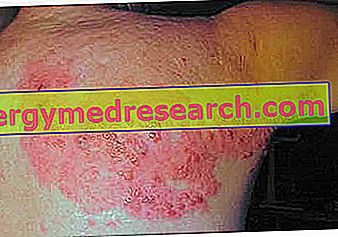Generality
Botany and description of the annual Artemisia
Artemisia annua is a plant belonging to the Asteraceae family, widespread especially in China, especially in the northern steppes above 1, 000 meters. Although extremely rare, Artemisia annua can also be found in Italy, in the Alpine regions and in the Swiss territories.

Figure: Annual Artemisia flowers
Characterized by a height that can reach and exceed 2 meters, with a cylindrical and branched stem, with small brown and dark green feliciform leaves, it is also distinguished by its bitter taste and small yellow flowers with a pleasant smell.
Uses of the annual Artemisia
Traditionally called "Chinese absinthe", "sweet absinthe" or "annual wormwood", the Artemisia annua has also found space in the United States, as a preservative and deodorant.
Of more recent introduction, also in the clinical field, are its essential oils; these, classically obtained by hydrodistillation of the flowering tops, are characterized by a different chemical profile, depending on the properties of the soil on which the plant is grown.
Essential oils of Artemisia annua
Careful chemical studies have characterized the complex chemical profile of the essential oil of Artemisia annua, detecting great differences in its main components.
The most abundant substances are represented by sesquiterpenes, followed by other polyphenolic antioxidants and by different ketones. Each of these molecules would seem to contribute to the complex biological role of these oils.
Indications
When to use Artemisia annua?
The Artemisia annua is indicated for various treatments. In fact, it exhibits different properties and efficacy, which make it applicable in many circumstances.
Above all, the Artemisia annua can be used:
- As an antimalarial remedy (a disease caused by the infestation of a parasite, especially Plasmodium falciparum )
- To fight bacterial and fungal infections
- To counteract oxidative stress, as an "anti-aging" ingredient
- To prevent and / or combat cardiovascular diseases of an atherogenic nature (thanks to the antioxidant action)
- As an antitumor adjuvant (we will see later that there are few scientific researches on the subject but offer encouraging results)
- Probably, to fight asthma.
Property and Effectiveness
What benefits has Artemisia annua shown during the studies?
Effectiveness of the essential oils of Artemisia annua
Different studies, mostly conducted in vitro, have associated with the essential oil of Artemisia annua:
- An antimicrobial activity, effective against both gram-positive and gram-negative bacteria, even when responsible for particularly serious clinical pictures. This activity is mostly supported by the ketones present in this plant
- An antioxidant activity, supported by the numerous polyphenolic compounds present, classifiable as coumarins, flavones, flavonols and phenolic acids
- As a consequence of the antioxidant activity, also a preventive action on atherosclerotic pathologies, which can determine cardiovascular events.
- An antimalarial activity, expressly supported by artemisinin and its derivatives, sesquiterpenes capable of interacting with protozoan iron atoms, thus inducing an oxidative shock responsible for the death of the parasite
- A potential antitumor activity, most likely supported by the terpene fraction of the essential oil, effective in controlling the aberrant tumor proliferation process, and assisted by the various polyphenolic compounds capable of exerting a significant genoprotective and antioxidant action
- An anti-asthmatic activity; Certain animal experiments have shown that the artesunate, a synthetic derivative of artemisinin, has antiallergic properties, as it determines the degranulation of the mastic cells. This makes the artisan a potential candidate for the treatment of allergic asthma.
In the face of the numerous molecules already identified, very recent studies continue to update the list of natural elements present in this plant, phytotherapically effective and in some way associated with the surprising therapeutic activities of Artemisia annua .
Success of the annual Artemisia
In traditional Chinese medicine (TCM), the Artemisia annua corresponds to the noun " qinghao ", which according to the national pharmacopoeia corresponds to the "dried aerial parts of the annual A. herbaceous plant".
Although Artemisia annua has always been used in traditional Chinese medicine for its antipyretic, carminative, but above all antibacterial properties, only in recent years has this plant, particularly some of its active ingredients, been particularly successful in the scientific community.
Starting from the now consolidated use of Artemisin in the treatment of malaria, this compound, together with its direct derivatives, has recorded an exponential increase in experimental studies on its clinical efficacy. Its applicative relevance was mostly related to the cytotoxic action, exerted with a high selectivity towards tumor cells. Numerous experimental studies and some clinical trials have demonstrated the oncoprotective efficacy of Artemisin and its derivatives, making them a valid ally to common chemo-therapeutic practices. Everyone hopes that this work can further clarify the mechanisms of action of artemisinin and thus formalize its use in an oncological clinic.
Doses and Mode of Use
How to use Artemisia annua?
The Artemisia annua can be used in different forms:
- Hydro-alcoholic solution
- Hydrolytic solution
- Capsule
- Dried drug.
The hydroalcoholic solution, the hydroalcoholic solution and the Artemisia annua capsules are preparations that contain almost exclusively artemisinin (considered the specific active principle) and are used above all in the treatment of pathologies (see above).
The most concentrated products reach 99% of titrated artimisina. As an antitumor adjuvant, antimalarial etc., Artemisia annua should be taken in several phases of the day, at least 3 times a day, possibly on a full stomach.
The dried drug, on the other hand, is mainly used to obtain infusions with antioxidant power.

Side effects
The possible side effects of the Artemisia annua are:
- Abdominal pain
- Diarrhea
- Nausea and vomit.
It has caused itching, hives and intense pain in injectable forms.
In some cases, changes in heart rate have been observed such as: bradycardia and prolongation of the QT interval.
The Artemisia annua pollen is potentially allergenic and, even in non-hypersensitive individuals, possibly responsible for headaches.
Contraindications
When should the annual Artemisia not be used?
The annual Artemisia is contraindicated in case of:
- Iron deficiency anemia
- Complications of the spleen
- Pregnancy (especially first trimester) and breastfeeding
- Dyspepsia and other digestive complications
- Gastric discomforts (gastritis, ulcer etc.)
- Nausea and vomit.
- Irritable bowel syndrome
- Diarrhea
- Hemorrhagic disorders
- Diabetes (Artemisia annua may cause hypoglycemia)
- Jaundice and liver complications
- Seizures.
Pharmacological Interactions
Which drugs or foods can modify the effect of Artemisia annua?
It is advisable to avoid annual Artemisia in the case of drug therapy for the treatment of cardiac arrhythmias (active ingredients to prolong the QT interval).
Artemisia annua can also interact with calcium channel blockers such as nifedipine (Procardia, Adalat), amlodipine (Norvasc), diltiazem (Cardizem) and verapimil (Calan, Isoptin, Verelan).
It should not be taken together with antifungal drugs such as griseofulvin (Gris-PEG), nystatin (Mycostatin), ketoconazole (Nizoral), fluconazole (Diflucan) and itraconazole (Sporanox)
No other specific interactions are known between Artemisia annua and commonly used drugs; for safety reasons, it is advisable to avoid the simultaneous intake of the active ingredients by interposing at least 2-3 hours between one and the other.
On the contrary, it is known that Artemisia annua should be avoided in the presence of other phytotherapeutic components:
- Citrus paradisi, also known as "grapefruit"
- Rheum (Genus), also known as "rhubarb"
- Angelicae sinesi, also known as "Chinese angelica"
- Rehmanniae (Genus), also known as "remannia".
Precautions for Use
What do you need to know before taking Artemisia annua?
It is strictly advisable to keep in mind what is stated in the paragraphs on side effects, contraindications and drug interactions.
Furthermore, when artemisinin is taken for more than a few weeks, the body begins to develop a certain level of tolerance. Many tend to increase the dose, but this is inadvisable; on the contrary, it is suggested to change product.
Prolonged use of the herb is very harmful, side effects begin to increase over time and some of them can be very dangerous.
Bibliography
Differential effect of artemisinin against cancer cell lines.
Tilaoui M, Mouse HA, Jaafari A, Zyad A.
Nat Prod Bioprospect. 2014 Jun; 4 (3): 189-96.
Essential Oil of Artemisia annua L .: An Extraordinary Component with Numerous Antimicrobial Properties.
Bilia AR, Santomauro F, Sacco C, Bergonzi MC, Donato R.
Evid Based Complement Alternat Med. 2014; 2014: 159819.
Flavonoids from Artemisia annua L. as antioxidants and their potential synergism with artemisinin against malaria and cancer.
Ferreira JF, Luthria DL, Sasaki T, Heyerick A.
Molecules. 2010 Apr 29; 15 (5): 3135-70.
Artemisinins: their growing importance in medicine.
Krishna S, Bustamante L, Haynes RK, Staines HM.
Trends Pharmacol Sci. 2008 Oct; 29 (10): 520-7.
Two new sesquiterpenoids from Artemisia annua.
Li HB, Yu Y, Wang ZZ, Yang J, Xiao W, Yao XS.
Magn Reson Chem. 2014 Oct 16.
New Sesquiterpene and Polymethoxy-Flavonoids from Artemisia annua L.
Chu Y, Wang H, Chen J, Hou Y.
Pharmacogn Mag. 2014 Jul; 10 (39): 213-6.



